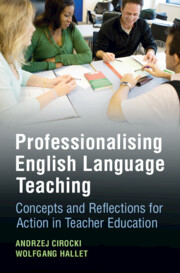 Professionalising English Language Teaching
Professionalising English Language Teaching Book contents
- Professionalising English Language Teaching
- Professionalising English Language Teaching
- Copyright page
- Dedication
- Contents
- Figures
- Tables
- Acknowledgements
- 1 English Language Teaching in the Twenty-First Century
- 2 Conceptualising Teacher Professionalism in English Language Teaching
- 3 Teacher Education and Professional Competences
- 4 Reflective Practice and Teacher-Led Research
- 5 Teacher Autonomy
- 6 Materials Development and Task Design
- 7 Teaching English in the Digital Age
- 8 Teacher Leadership
- 9 Building Professional English Language Teaching Development Communities
- References
- Index
- References
References
Published online by Cambridge University Press: 24 October 2024
- Professionalising English Language Teaching
- Professionalising English Language Teaching
- Copyright page
- Dedication
- Contents
- Figures
- Tables
- Acknowledgements
- 1 English Language Teaching in the Twenty-First Century
- 2 Conceptualising Teacher Professionalism in English Language Teaching
- 3 Teacher Education and Professional Competences
- 4 Reflective Practice and Teacher-Led Research
- 5 Teacher Autonomy
- 6 Materials Development and Task Design
- 7 Teaching English in the Digital Age
- 8 Teacher Leadership
- 9 Building Professional English Language Teaching Development Communities
- References
- Index
- References
- Type
- Chapter
- Information
- Professionalising English Language TeachingConcepts and Reflections for Action in Teacher Education, pp. 237 - 275Publisher: Cambridge University PressPrint publication year: 2024
